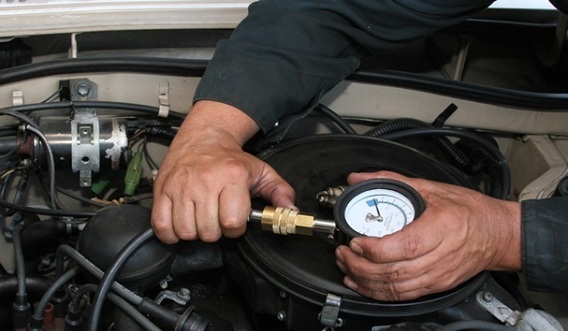
Compress is one of the main characteristics of the engine. Note that compression and compression are not the same. Compress is the maximum cylinder pressure created by a piston from the bottom of the dead point to the top. Compress compression depends on compression: compression increases and compression increases.
The compression value can tell a lot about the condition of the engine, so it is necessary to be able to measure the compression of the engine and correctly "decode" the resulting data from a specific engine.
How do we measure the compression in the engine?
A compressor is used to measure compression. In fact, it is a non-return valve equipped with a non-return valve, which allows to measure the pressure in the cylinder.
By way of fixation, the compressor can be either:
- threaded (fixed in a candle-hole),
- with the anthem (has a rubber stick that needs to be pressed and kept in the compression measurement process).

For diesel engines, the compressor is designed for higher pressure and is mandatory.
How do I measure compression in an engine cylinder?
The compression shall be measured with a properly charged battery. The engine shall be warmed up to the operating temperature (80-90 °). You're going to need an assistant to measure the compression in the engine cylinder.
To measure the compression in the engine, you need to do the following:
- Remove all spark plugs by remembering the location of each cylinder. If you only pull the candle out of that cylinder where the compression is measured, the data will be lower than it really is.
- Detach the low-voltage wire from the carcasses to avoid punctating.
- Remove the fuel hose from the pump if the gas pump is mechanical. If the pump is electric, it is necessary to remove the relays or safety relays or to remove the power supply from the nozzles. In this way, you will prevent the fuel from being fed into the cylinders during the compression measurement process.
- Lock the compressors in the candle well (secure the hymn or steep the threaded hole).
- Ask the assistant before the gas pedal is pressed (the throttle control opens) and start spinning the engine starter.
- The first two to three seconds on the compressor scale will grow, then stop.
- Turn off the starter, lock the compressor at the compressor station, which is the compression in the cylinder.
- Reset the compressor station and repeat the procedure for each cylinder.
If the compression is significantly different in one of the cylinders, repeat the measurement procedure to ensure that the results are satisfied.
What should be the compression of the engine
Normal compression ratios are individual for each engine. As you begin the compression check procedure, you should examine the technical documentation of the car to find out what is normal.
At the same time, it is worth drawing attention not only to the size of compression in one single cylinder, it is best to look at the results of measurements relative to each other.
Thus, for example, a reduced compression in one cylinder may be an indication of the burn of piston rings. If the compression is low in two adjacent cylinders, it can be assumed that a gasket was burned between them.







